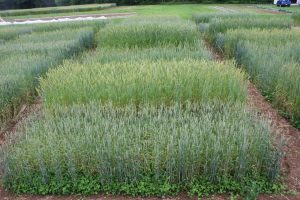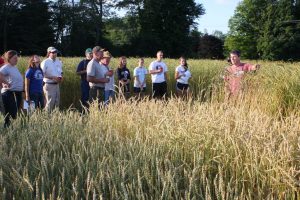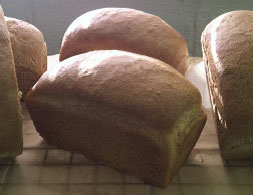Winter Spelt Variety and Planting Date Trial

Richard Kersbergen, Ellen Mallory, and Tom Molloy
2012 Winter Spelt Variety and Planting Date Trial (PDF)
Introduction
Spelt is a relative of wheat that evolved thousands of years ago in the Near East and Europe, as people first began to cultivate grains. European settlers brought the grain to the U.S. in the late 1800s, and it remained popular for decades. By the 1920s, however, spelt had fallen out of favor as a food for human consumption for several reasons, including its inconsistent yields and need to be dehulled.
More recently, spelt has re-emerged as a viable product in the health food and local grain markets, both in the U.S and in Europe. On a recent trip to Denmark to visit organic wheat growers and processors we were amazed at the number of spelt products and popularity of the grain with farmers and consumers. Many consumers say spelt is much easier to digest than wheat and its nutrients are more “bioavailable,” that is, more readily accessed during digestion. While spelt does contain gluten and is not suitable for people with Celiac’s disease, many people who have sensitivity to wheat can digest spelt products.
Spelt has been grown in Maine and has been investigated as a possible grain for feeding organic dairy cows. See:
- SARE Project Number: FNE06-587 Growing winter spelt as an organic grain or forage for dairy cows, http://sare.org/MySare/ProjectReport.aspx?do=viewProj&pn=FNE06-587
- SARE Project Number: LNE06-240 Expanding grain production and use on organic dairy farms in Maine and Vermont, http://www.sare.org/MySare/ProjectReport.aspx?do=viewProj&pn=LNE06-240
Spelt has not, however, been evaluated as a food-grade grain in Maine or Northern New England. Using data from trials conducted in other regions is insufficient because different soil and environmental conditions, as well as different varieties of spelt, impact the quality and nutritional profile of the grain. Research in Saskatchewan, Canada has indicated that spring spelt varieties may also have a place in Maine if sown early in the season (http://library2.usask.ca/theses/available/etd-10212004-001220/). There is a need to evaluate suitable varieties of spelt for Northern New England, especially varieties of winter spelt that are winter hardy and can potentially resist Fusarium infection. Fusarium has been a major issue in wheat production in the more humid Northeast.
Methods
We tested four varieties of Winter Spelt during 2012 at the University of Maine Rogers Research Farm. Each variety was planted at three different dates in the fall of 2011 to test whether the varieties differed in their tolerance of late planting. The plots were managed organically with dairy manure as the primary source of fertility applied before planting at a target rate of 70 lbs of nitrogen per acre. Spelt grain was harvested on 1 August 2012. All samples were tested for DON (the deoxynivalenol mycotoxin produced by the Fusarium head blight fungus).
The harvested spelt was milled and sifted at the Somerset Grist Mill in Skowhegan, Maine. This company is very interested in obtaining more locally produced spelt to process and sell. Spelt Right Foods LLC (Beth George) conducted baking tests. Originally in Yarmouth Maine, Spelt Right has recently moved to NJ. In order to have enough flour for the bake tests, we combined each variety across planting date. The crude protein levels for the combined samples were calculated as weighted averages and were: Comet – 12%, Maverick – 11%, Oberkulmer – 15% and Sammy – 13%.
The varieties tested were Comet, Maverick, Oberkulmer, and Sammy. All were acquired from French’s Hybrids, Inc., Wakeman, OH (440.839.2934/800.977.0998, www.frenchshybrids.com). Variety descriptions can be found on their website.
Results

Yields and protein levels were good for all of the varieties. The 2011-2012 season was exceptionally good for winter grains, with a mild fall and early spring, and this is reflected in yields ranging from just over one ton per acre for Oberkulmer to over 1.8 ton per acre for Maverick (Table 1). Oberkulmer, the tallest of the varieties, did have some lodging issues and would probably require a lower fertility rate. Grain protein levels were inversely related to yields, with Oberkulmer having the highest protein concentration and Maverick having the lowest. Similarly, later planting dates produced lower yields, but higher protein levels (Table 2). DON levels were below the 0.5 detectable limit of the test we use for all of the spelt samples.
One spring spelt variety (an unnamed “common” variety) was planted in two locations in 2012, both in association with organic spring bread wheat variety trials. Spring spelt yields were markedly different most likely due to differences in nitrogen fertility. At the dairy farm in Sidney, which received approximately 55 pounds of N per acre as dairy manure, the spring spelt yielded 1401 pounds per acre. In contrast, at the University of Maine Smith Farm in Old Town, Maine, where plots received approximately 70 pounds of N per acre as dairy manure and an additional 16 pounds of N as Chilean nitrate topdress, the spelt yielded 3027 pounds per acre, which is comparable to the winter spelt yields.
Table 1. Plant height, grain yield and grain protein of 4 winter spelt varieties, averaged over three seeding dates.
| Spelt Variety | Plant Height | Grain Yield at 13.5% moisture | Grain Protein at 12% moisture |
|---|---|---|---|
| (inches) | (lbs per acre) | (%) | |
| Comet | 33 | 3261 ab | 12.4 b |
| Maverick | 43 | 3741 a | 10.9 c |
| Oberkulmer | 54 | 2231 c | 14.7 a |
| Sammy | 40 | 2706 bc | 12.9 b |
Values within a column that share a letter in common are not statistically different.
Table 2. Effect of fall planting date on winter spelt plant height, grain yield, and grain protein, averaged over 4 varieties.
| Planting Date | Plant Height | Grain Yield | Grain Protein |
|---|---|---|---|
| (inches) | (lbs per acre) | (%) | |
| September 18 | 37 | 3546 a | 12.0 b |
| October 6 | 33 | 2975 b | 13.0 ab |
| October 18 | 32 | 2434 c | 13.3 a |
Values within a column that share a letter in common are not statistically different.
Bake Test Report — from Spelt Right Baking

The first trial was on November 29, 2012 in which we used the Maverick spelt. We used 50% hydration, and the same proprietary formula and procedure that we use with our whole grain spelt from other sources. Interestingly, in this trial, the bread structure held up better as compared to our standard bread. The structure of the crumb held up very well, and the texture was light. Persons familiar with the standard whole grain Spelt Right bread consistently said that they thought Maverick had a taste and texture more aligned with “whole wheat” rather than the “whole spelt” to which they were accustomed. The overall response, however, was very positive and we were extremely pleased with the commercial appeal of the bread.
We conducted the second trial on December 3, 2012. We made two separate formulas using 10lbs of Oberkulmer and 10lbs of Comet. The dough was very heavy for both of these varieties, so I added an extra 6 ounces (2.87%) of water to the Oberkulmer and an extra 12 ounces (5.75%) to the Comet. Both varieties were in the proofer for the same amount of time, but were proofed at a temperature that was slightly too high (as we were trying to hasten the proofing time given time constraints). The Oberkulmer structure fell (you will see by the flat tops on the loaves), and the Comet held up relatively well. The crumb of the Oberkulmer was frail and could not hold up to spreads like the cooled butter or peanut butter. The crumb of the Comet was sturdy and would make perfect sandwich bread. (The picture does not do justice to the quality of the Comet bread). The resounding response from six individuals who tried all three breads was that the taste and the texture of the Comet was by far the best. Also, the six who were testing the bread all were surprised as to how different each variety tasted. The only change in any of the formulas was the spelt variety; all other ingredients remained consistent.
On December 13, 2012, we did a trial bake with Sammy and then with a mix of all the varieties. The bakes failed dismally, because we changed a variable we should not have changed: the bread pans. We were trying new bread pans and the gauge was not heavy enough and the breads were not able to proof or bake properly. The failed breads will be used for breadcrumbs or other non-sandwich uses.
On December 18, 2012, we did another trial run with the remaining 2.5 pounds of Sammy that we had. The breads came out well with a good structure, nice crumb, and sturdy crust. We have three of those breads (but no photo), which we will provide to the University of Maine System.
Bake Test Conclusion: Depending upon multiple factors, including demand, quality, availability, and price, Spelt Right would be interested in continued discussions of the possibility of working with the State of Maine through the University of Maine Extension program and the Maine Department of Agriculture in developing spelt as a staple crop in Maine.
Other small grain resources:
Growing Organic Cereals: A fact sheet was developed to assist growers interested in all winter and spring organic grains. By Extension Educator Richard Kersbergen, Sustainable Agriculture Specialist Ellen Mallory, and Research Associate Tom Molloy.
Organic Wheat and Barley Enterprise Budgets: These budgets can be modified for any grain, including spelts. By Dan Kerry, Tom Molloy, and Ellen Mallory.
This research was funded by an Integrated Research/Extension Grant from the Maine Agricultural Center.
